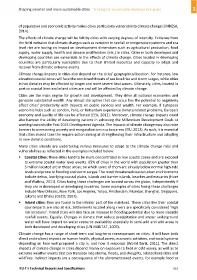Page 561 - Shaping smarter and more sustainable cities - Striving for sustainable development goals
P. 561
of population and economic activity makes cities particularly vulnerable to climate change (UNDESA,
2014).
The effects of climate change will be felt by cities with varying degrees of intensity. Evidence from
the field indicates that climatic changes such as variation in rainfall or temperature patterns and sea
level rise are having an impact on development dimensions such as agricultural production, food
supply, water supply, health and disease proliferation (etc.) in cities. Cities in both developed and
developing countries are vulnerable to the effects of climate change. Cities located in developing
countries are particularly susceptible due to their limited resources and capacity to adapt and
recover from climatic extreme events.
Climate change impacts in cities also depend on the cities' geographical location. For instance, low
elevation coastal zones will face the combined threats of sea level rise and storm surges, while cities
in hot climates may be affected by longer and more severe heat waves. Ultimately, cities, located in
port or coastal lines and inland cities are and will be affected by climate change.
Cities are the main engine for growth and development. They drive all national economies and
generate substantial wealth. Any abrupt disruption that can occur has the potential to negatively
affect cities' productivity with impacts on public services and wealth. For example, if European
economic hubs such as London, Paris, or Rotterdam experience climate related problems, Europe's
economy and quality of life can be affected (EEA, 2012). Moreover, climate change impacts could
also hamper the ability of developing nations in achieving the Millennium Development Goals or
working towards the Post 2015 Development Agenda. The impacts of climate change may also raise
barriers to overcoming poverty and marginalization in urban areas (ITU, 2012). As such, it is essential
that cities should take the require action aiming at strengthening their infrastructure and adapting
to new climatic conditions.
Many cities already are undertaking various measures to adapt to the climate change risks and
vulnerabilities as reflected in the examples included below:
Coastal Cities: these cities tend to be more concentrated in low coastal zones and are exposed
to extreme coastal water level events. 65% of cities in the world with population greater than
5 million located are in these areas; on which some of them are already below normal high‐tide
levels and prone to flooding and storm surges. The most threatened coastal urban environments
include deltas, low‐lying coastal plains, islands and barrier islands, beaches and estuaries (Hunt
and Watkiss, 2011). Cities facing these challenges are located across the globe, independently if
they are in developed or developing countries. Some examples of cities facing these challenges
include New Orleans, New York, Los Angeles, Tokyo, Amsterdam, Mumbai, Shanghai, Singapore,
Jakarta and Dhaka (OECD, 2007).
Inland cities: they are found in the interior part of the mainland. These cities like their coastal
counterparts are also at risk. Settlements located along rivers are specifically considered 'high
risk locations'. Inland cities will also face an increase in flooding potential due to more sizeable
rainfall events. Equally, Changes in climate that reduce precipitation and impair underground
water will have impact on water resource availability especially in semi‐arid and arid areas in
both developed and developing cities (UN‐HABITAT, 2009).
Climate change has a range of short‐term and long‐term consequences on cities. It will have both
direct and indirect impacts on human health, physical assets, economic activities, and social systems
depending on how well prepared a city is, and how it responds (World Bank, 2011). The direct
impacts of climate change in cities depend mainly on exposure to heat or cold waves, as well as to
extreme weather events that can translate into storms, floods, and droughts, related landslides and
wildfires. Indirect impacts are a consequence of the aforementioned events, for example food or
ITU‐T's Technical Reports and Specifications 551

